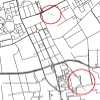The impact of urban road network morphology on pedestrian wayfinding behavior
Keywords:
pedestrian wayfinding, wayfinding heuristics, network morphology, trajectory data analysis, map matching, path similarity, computational movement analysis, GPSAbstract
During wayfinding pedestrians do not always choose the shortest available route. Instead, route choices are guided by several well-known wayfinding strategies or heuristics. These heuristics minimize cognitive effort and usually lead to satisfactory route choices. Our previous study evaluated the costs of four well-known pedestrian wayfinding heuristics and their variation across nine network morphologies. It was observed that the variation in the cost of these wayfinding heuristics increased with an increase in the irregularity of the network, indicating that people may opt for more diverse heuristics while walking through relatively regular networks, and may prefer specific heuristics in the relatively irregular ones. The study presented here aims to investigate this claim by comparing simulated routes with observed pedestrian trajectories in Beijing and Melbourne, two cities at opposite ends of the regularity spectrum. We found that the values of mean route length and mean Network Hausdorff Distance for walking trips made in Melbourne were consistently lesser than the corresponding values obtained in Beijing. Also, across both the cities, we found that while there was minimal variation in the popularity of heuristics overall, in cases where different heuristics produced dissimilar routes, the shortest leg first strategy and the least angle strategy were more popular.

Downloads
Published
Issue
Section
License
Copyright (c) 2020 Debjit Bhowmick, Stephan Winter, Mark Stevenson, Peter Vortisch

This work is licensed under a Creative Commons Attribution 4.0 International License.
Articles in JOSIS are licensed under a Creative Commons Attribution 3.0 License.
